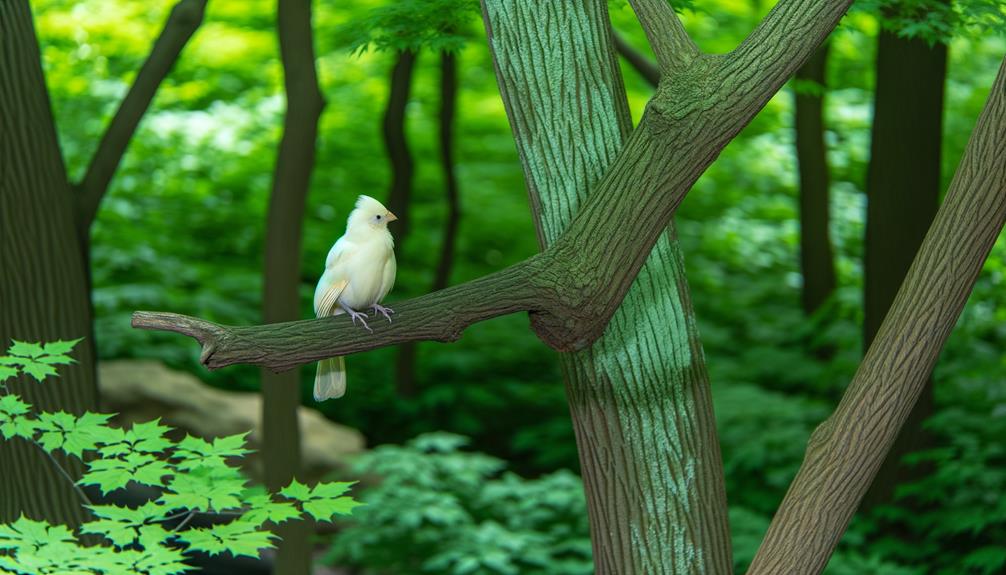Do White Yellow and Orange Cardinals Exist?
White, yellow, and orange cardinals do exist, though they are rare. Genetic mutations and dietary factors primarily drive these color variations.
Approximately 1 in 1,800 cardinals exhibit leucism, resulting in white feathers. Yellow cardinals are even rarer, with few documented sightings, typically caused by a mutation in the CYP2J19 gene affecting carotenoid pigments.
The existence of orange cardinals results from a combination of these genetic factors and dietary influences. The interplay between specific genes, pigments, and available nutrients leads to this diverse plumage.
Exploring these conditions reveals more about unexpected cardinal diversity.

Key Takeaways
- Yes, white, yellow, and orange cardinals exist due to genetic mutations affecting pigmentation.
- Leucism causes approximately 1 in 1,800 cardinals to display white feathers.
- Yellow cardinals are extremely rare, with only a few confirmed sightings.
- Mutations in the CYP2J19 gene can lead to yellow or orange plumage in cardinals.
- Dietary factors, such as carotenoid intake, can influence cardinal plumage coloration.
Color Variations in Cardinals

Scientists have documented significant color variations in cardinals, with some individuals displaying striking white, yellow, or orange plumage. Observations reveal that these variations are rare but notable.
For instance, one study reported that 1 in every 1,800 cardinals exhibits leucism, resulting in white feathers. In contrast, yellow cardinals are even rarer, with only a handful of confirmed sightings. Detailed field observations and photographic evidence have validated these occurrences.
Orange variants, though seldom seen, also contribute to the spectrum of cardinal coloration. These color differences aren't linked to geographical regions but appear sporadically across cardinal populations. Such findings underscore the genetic diversity within the species, prompting further investigation into the underlying causes of these vivid deviations.
Genetics of Cardinal Colors
In examining the genetics of cardinal colors, understanding the role of pigments like carotenoids and melanins that influence their hues is crucial.
Genetic mutations can lead to variations such as white, yellow, or orange plumage, which deviate from the typical red. These mutations impact pigment production and deposition, resulting in observable color differences.
Pigment Influence on Color
The vibrant colors of cardinals—ranging from white to yellow to orange—are determined by the specific pigments produced through their unique genetic makeup. Carotenoids, melanins, and porphyrins are the primary pigments influencing these hues. Carotenoids, obtained from their diet, generate yellows and oranges. Melanins, synthesized in the body, create darker shades. Porphyrins contribute to reds and browns, though less common in cardinals. Each pigment type's presence and concentration are governed by genes, dictating the final coloration.
| Pigment Type | Resulting Color Range |
|---|---|
| Carotenoids | Yellow to Orange |
| Melanins | Dark Shades |
| Porphyrins | Reds and Browns |
These pigments, combined in varying proportions, result in the striking diversity seen in cardinal populations.
Genetic Mutations in Cardinals
Genetic mutations play a significant role in altering the pigmentation pathways in cardinals, leading to the rare appearances of white, yellow, or orange individuals within the species. These deviations from the typical red coloration can result from mutations affecting the carotenoid pigment absorption and conversion processes.
For instance, the mutation of the CYP2J19 gene impairs the conversion of dietary carotenoids into red pigments, resulting in yellow or orange plumage. Albinism, caused by mutations that inhibit melanin production, results in white cardinals. Observations have recorded these genetic anomalies at a rate of approximately 1 in 1,800 cardinals.
Such data underscore the importance of genetic diversity and its role in driving the visual spectrum within cardinal populations, offering a proof to nature's unpredictability and splendor.
Albinism in Cardinals

Although rare, albinism in cardinals results from a genetic mutation that hinders melanin production, leading to a complete absence of pigmentation. This condition manifests in entirely white plumage, pink eyes, and pale beaks. Albinism's scarcity among cardinals makes sightings remarkable, often prompting detailed documentation.
Observations reveal:
- Physical Characteristics: Albino cardinals display pure white feathers, setting them apart from their typically vibrant counterparts.
- Vision Impairment: Reduced melanin impacts their vision, rendering them more susceptible to predators.
- Life Expectancy: These birds generally have shorter lifespans due to predation and health issues associated with albinism.
- Reproductive Challenges: Albinism may influence reproductive success, as these cardinals often encounter heightened difficulties in attracting mates.
Such notable documentation enhances understanding and appreciation of these unique avians.
Leucism: White Cardinals
Leucism, caused by a genetic mutation, results in partial loss of pigmentation, producing white cardinals with normal eye color.
Birdwatchers have reported rare sightings of these leucistic cardinals, noting their distinct appearance compared to standard red cardinals.
Observational data indicates that leucism doesn't affect the birds' overall health or behavior.
Genetic Mutation Explanation
Researchers attribute the unusual white plumage in cardinals to a genetic condition known as leucism, which results in a partial loss of pigmentation. Unlike albinism, which affects melanin production entirely, leucism only impacts certain pigments.
Detailed observations reveal several characteristics:
- Feather Pigmentation: Leucistic cardinals may have white feathers but retain normal eye color.
- Genetic Basis: The mutation affects pigment cells, not melanin production, allowing partial pigmentation.
- Variability: The extent of leucism can vary, from a few white patches to entirely white plumage.
- Survivability: Leucistic birds might face higher predation due to their conspicuous coloration.
These data points offer insight into the genetic underpinnings of leucism, showcasing the complexity behind these rare avian appearances.
Birdwatching Rare Sightings
Spotting a leucistic cardinal in the wild delights birdwatchers and provides unique opportunities for data collection on this rare genetic variation. Leucism, distinct from albinism, results in white or pale plumage while retaining normal eye color.
Observers have documented leucistic cardinals in various regions, noting their rarity at approximately 1 in 1,800 cardinals. These sightings offer valuable insights into genetic diversity and avian adaptation. Birdwatchers often use high-resolution cameras and GPS tagging to track these individuals, contributing data to ornithological studies.
The challenge lies in distinguishing leucistic birds from other white-plumaged species. Accurate identification guarantees that collected data enhances understanding of leucism's ecological impacts, providing a broader perspective on avian genetic anomalies.
Yellow Cardinals Explained

The yellow cardinal, a rare and striking variant, owes its unique coloration to a genetic mutation that alters the bird's ability to process pigments. This mutation impacts the deposition of carotenoids, resulting in yellow feathers instead of the typical red.
Detailed observations reveal that these yellow cardinals aren't a separate species but rather a color morph of the common northern cardinal.
Key factors contributing to the yellow coloration include:
- Genetic Mutation: A specific alteration in the CYB5A gene.
- Pigment Processing: Inability to convert yellow dietary pigments to red.
- Diet: Similar diet to red cardinals, primarily seeds and fruits.
- Geographic Distribution: Rare sightings primarily in southeastern United States.
This phenomenon underscores the genetic diversity within avian species.
Orange Cardinals: Rare or Real?
Orange cardinals, though rare, have been documented and are attributed to specific genetic mutations altering feather pigmentation.
Observations indicate regional sightings mainly in southeastern United States, with sporadic reports elsewhere.
These mutations disrupt normal carotenoid processing, resulting in the distinctive orange hue.
Genetic Mutation Explanation
Many avian biologists attribute the occurrence of orange cardinals to a genetic mutation affecting the carotenoid pigments in their feathers. This mutation alters the birds' ability to metabolize dietary carotenoids, resulting in an atypical orange hue.
Detailed observations indicate:
- Carotenoid Metabolism: Mutations impact enzymes critical for converting dietary pigments.
- Pigment Variation: Affected cardinals show a spectrum from pale orange to deep rust.
- Genetic Inheritance: Studies suggest the mutation follows a recessive inheritance pattern.
- Population Data: Less than 1% of cardinal sightings document orange variants.
These findings underscore the rarity and genetic basis of orange cardinals, contributing valuable insights into avian coloration genetics. Detailed genetic sequencing may further elucidate specific mutation pathways involved.
Regional Sightings Report
Across various regions, documented sightings of orange cardinals remain exceedingly rare, with only sporadic reports emerging from specific locales. Detailed observations indicate these sightings are often isolated incidents, suggesting a potential genetic anomaly rather than a widespread occurrence. Reports are scattered, making it difficult to establish a definitive pattern or frequency.
| Region | Number of Sightings | Year of Report |
|---|---|---|
| Southeastern US | 3 | 2018-2021 |
| Midwest US | 1 | 2019 |
| Northeast US | 2 | 2020-2022 |
The rarity of these sightings underscores the unusual nature of orange cardinals. Birdwatchers and ornithologists remain vigilant, documenting each occurrence meticulously to enhance understanding of this rare phenomenon. The data suggests that while real, orange cardinals are exceptionally uncommon.
Documented Sightings of Color Variants

Numerous ornithological records detail sightings of cardinals exhibiting unusual plumage colors such as white, yellow, and orange, challenging the traditional perception of the species' red coloration. Observational data reveal these color variants aren't mere anomalies but documented phenomena.
Specific instances include:
- White Cardinals: Leucistic individuals have been observed in various states, particularly in Alabama and Pennsylvania.
- Yellow Cardinals: A rare yellow cardinal was documented in Alabama in 2018, attracting significant scientific interest.
- Orange Cardinals: Sightings of orange-hued cardinals have been reported, though less frequently, in regions like Florida and Texas.
- Mixed Variants: Instances of cardinals with mixed red and yellow plumage have also been recorded, indicating complex genetic variations.
These sightings underscore the diversity within cardinal populations.
Impact of Diet on Plumage
Emerging research suggests that dietary factors may play a key role in the unusual plumage colors observed in cardinals, with specific nutrients influencing pigmentation. Studies indicate that carotenoids, found in many fruits and seeds, are essential for red coloration.
However, a deficiency or variation in these dietary components can lead to yellow or orange feathers. For instance, cardinals consuming a diet low in carotenoids but rich in other pigments may exhibit yellow or orange hues.
Additionally, white cardinals may result from genetic mutations affecting melanin production rather than dietary factors. Detailed field observations and controlled experiments have shown that the birds' access to specific nutrients profoundly affects their coloration, providing a data-driven understanding of these color variations.
Misidentification With Other Birds

Misidentification of white, yellow, or orange cardinals with other similarly colored birds often occurs due to overlapping habitats and similar plumage characteristics. Detailed observations reveal that certain species are frequently mistaken for cardinals:
- American Goldfinch: Exhibits vibrant yellow plumage, often leading to confusion.
- Baltimore Oriole: Displays striking orange feathers, sometimes mistaken for orange cardinals.
- Leucistic Northern Cardinals: Possess white plumage due to a genetic mutation, easily confused with albino or white cardinals.
- Summer Tanager: Features reddish-orange hues that can be misidentified as orange cardinals.
These instances of misidentification underscore the importance of precise birdwatching and ornithological research. Only through careful study and documentation can accurate data on cardinal coloration be maintained, ensuring the freedom to explore avian diversity without misconceptions.
Potential Causes of Color Mutations
Genetic mutations, dietary influences, and environmental factors are primary drivers behind the atypical coloration observed in cardinals.
Specific genetic mutations can alter pigment production, leading to white, yellow, or orange feathers instead of the usual red.
Dietary influences also play a significant role; a deficiency or abundance of specific carotenoids, compounds responsible for red coloration, can yield varied hues.
Environmental factors, including exposure to pollutants or habitat changes, can further impact feather pigmentation.
Studies have documented cases where cardinals exhibit leucism, a genetic condition causing white plumage, or xanthochromism, where yellow replaces red due to carotenoid variations.
Such data reveal the intricate interplay between genetics, diet, and environment in determining cardinal coloration.
Conclusion
Research reveals that while typical cardinals are red, rare color variations such as white, yellow, and orange do exist. Genetic mutations, like albinism and leucism, and dietary factors contribute to these anomalies.
Documented sightings and detailed observations confirm these unique colorations. It's essential to distinguish these rare cardinals from similar species to avoid misidentification.
By understanding these genetic and environmental influences, scientists can further unravel the complexities of avian plumage diversity.






